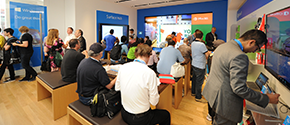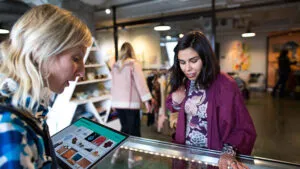
Creating immersive, digitally-enhanced retail experiences
A company’s relationship with customers is fundamentally different today. In the old world, customers were passive recipients of goods and services. Today they are active participants in product development, feedback, and in many cases the actually marketing and communications for a brand or organization. Think of the power of #fail on twitter.
Additionally, computing is moving toward a more emotionally-intelligent future, with technology subtly embedded in our everyday environment. Wearables and sensors are increasingly adept at tuning technology to the behavior and emotions of users. As a result, devices are becoming more intuitive and more pervasive in users’ everyday lives, with vast potential for improving productivity, personalized marketing, and immersive experiences. How entities respond to this shift will determine the next generation of disruptive organizations.
Retailers are leading the way in responding to the age of the customer, and Microsoft is no exception. Recently, Microsoft Retail stores set sail into unexplored waters with multi-story, flagship stores in New York City and Sydney, charting the course to new experiences for customers in those communities. The stores—on Manhattan’s stylish Fifth Avenue and in the bustling and trendy Pitt Street Mall in Australia’s biggest city—let customers interact with, and more fully explore, Microsoft and partner products, Microsoft online services, and the Microsoft brand before leaving the store. In addition to consumers, the two new stores offer an opportunity for partners and commercial business leaders to experience devices and productivity solutions.
“Suddenly we’re not talking just to consumers, but we’re reaching out to small business, enterprise, and education, and saying this store can represent a lot of things to different people.” Charlie McNerney, vice president, Microsoft Retail IT.
In Manhattan’s seven-floor building, Microsoft retail is the equivalent of two floors. There’s a Dell store on floor three, and above that is employee space, as well as conference, exhibition, and learning areas for everything from training to customer meetings. The Sydney store also features a conference meeting space so that the local Microsoft sales team can host customers, let them interact with devices, and show them how to be more productive with devices and online services.
McNerney tells the story of a father and daughter who walked into a Microsoft store to purchase a back-to-school notebook. The staff showed them the considerable abilities of the Microsoft Surface Pro, and it so impressed the daughter that she walked out with one. Her father, who is the senior product manager for a major furniture company, was able to utilize store experiences to envision how Microsoft technologies could improve his business, and purchased 1,100 unites only weeks later.
Representatives from the Seattle Mariners baseball team were another store visitor. Evaluating productivity and business process management tools, the enterprise sales team engaged in several ways with this customer to win their business, McNerney recalls. Ultimately it was team officials’ visit to a local Microsoft store, and experiencing the software in real world situations, that won their confidence and confirmed their decision to purchase Microsoft Dynamics CRM.
To ensure both immersive and trusted customer experiences, IT and business leaders must partner much more closely together. In 2016, exceptional customer service and experiences will be among the top critical success factors for leading businesses. At the same time, rising customer awareness and concerns regarding security and privacy offer a way for businesses to differentiate and deepen their customer relationships. Business and IT leaders can effectively partner to deliver both. We recognize the convergence of business and personal productivity, and adopt an attitude of “trusted by the pros, built for the fans” in everything we do.
Microsoft IT has adjusted to this convergence with people training and hiring new skills, while Microsoft Retail store associates have more IT solutions-centric skills. The in-store infrastructure runs on Microsoft Azure, while fixed pay stations all utilize the latest Microsoft Surface devices that run Microsoft Dynamics AX and CRM, which allows Microsoft enterprise sales force to demonstrate products to enterprise customers.
What’s next? Wearable devices and connected products make possible a deeper intimacy with consumers, tracking their needs, behaviors, and even their emotions. These technologies give marketers the opportunity to get in front of customers with personalized offers. Coordinating both digital and in-person sales experiences with positive emotion also helps capture the consumer’s attention (that precious currency of today’s economy) and make a memorable impact.





